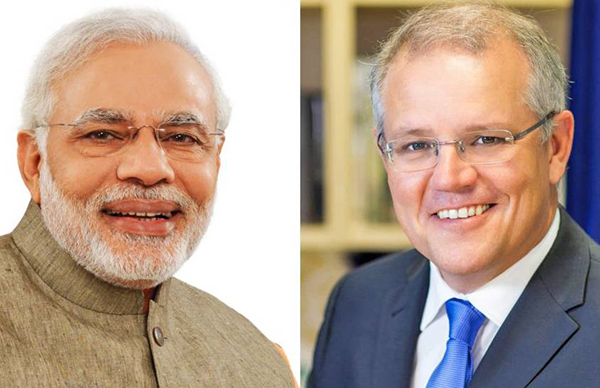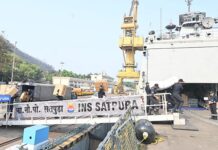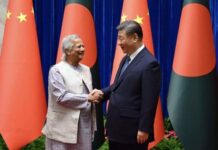
Australia is likely to be invited to attend Exercise Malabar, which is planned at the end of 2020. It will be the first time all members of the Quadrilateral Security Dialogue (Quad) will be participating in a maritime exercise since 2007. In the midst of the Galwan standoff, a virtual summit was held between Prime Minister Modi and Prime Minister Scott Morrison on 4 June resulting in the signing of two Defence Agreements. These were the landmark Australia – India Mutual Logistic Support Agreement and the Defence Science & Technology Implementing Arrangement.
They upgraded their strategic ties to a ‘Comprehensive Strategic Partnership’, and signed other science and technology agreements among the nine bilateral cooperation documents following a discussion at the virtual summit.
The ‘Arrangement concerning Mutual Logistics Support‘ (MLSA) will allow militaries of the two countries to use each other’s bases for repair and replenishment of supplies besides facilitating scaling up of overall defence cooperation.
The ‘Implementing Arrangement concerning cooperation in Defence Science and Technology to the MoU on Defence Cooperation’ was also signed.
Shared Vision
India is a member of the Quadrilateral Security Dialogue along with Australia, Japan, and the US. With these agreements in place it is expected that Australia would be invited for the annual multilateral exercise Malabar comprising of India, US and Japan. The third edition of AUSINDEX-2019 was held in the Bay of Bengal in April 2019.
The other pacts will provide for bilateral cooperation in areas of cyber and cyber-enabled critical technology, mining and minerals, military technology, vocational education and water resources management.
ALSO READ Global Times Warns Australia Over Supporting India
Modi and Morrison also decided to announce a ‘Shared Vision for Maritime Cooperation in the Indo-Pacific Region‘ to “harness opportunities and meet challenges together” as ‘Comprehensive Strategic Partners‘.
India has previously signed logistics support agreement, called Logistics Exchange Memorandum of Agreement, with the United States in 2016 under which the two nations’ military assets such as warships will receive reciprocal cashless supplies while docked at each other’s port. The two nations have also pursued the Defence Technology and Trade Initiative (DTTI) since 2012 for cooperation on military technology joint development and production.
Bilateral Cooperation
The bilateral economic engagement too has been on an upswing in the last few years. According to official data, the trade between the two countries was around USD 21 billion in 2018-19.
Australia’s cumulative investment in India is about USD 10.74 billion whereas India’s total investment in Australia is USD 10.45 billion. Australian Super Pension Fund has invested USD 1 billion in India’s National Investment and Infrastructure Fund. In the last few years, both the countries have been focusing on expanding maritime cooperation.
Historical Background
Indian and Australian troops first fought together in 1915 in the trenches of Gallipoli against the Turks and thereafter against the onslaught of the Afrika Korps led by Rommel during the siege of Tobruk in 1941. They have also fought shoulder to shoulder in the jungles of Malaya and in the Far East.
ALSO READ GEOPOLITICS: Indo-Australian Bonhomie Influenced by Chinese Hostility
The two countries also share a common love for cricket and sporting ties are second only to those of war.
Pre partition, both India and Australia were part of the British Empire, while India was ruled by the British, Australia was a self-governing dominion.
Australia prides itself on being a multi-cultural society and in a population of 25 million over 1.2 million are ethnic Chinese whereas Indians are nearly 7 lacs representing over 2.8 % of the population. Indians are, however, the highest growing migrant community.
The Andaman & Nicobar Islands became part of India in 1950. Thereafter, the paths of India and Australia diverged with the cold war. Australia is firmly aligned with the US and India on the path of non-alignment.
In 1990, Australia sold 50 Mirage III aircraft which had been decommissioned by the Royal Australian Air Force (RAAF) in 1988 to Pakistan.
Australia not only condemned India’s nuclear tests conducted in 1998, but also suspended all bilateral defence ties including recalling Australian officers attending courses in India, doubling military aid to Pakistan, which it cancelled after Pakistan conducted its nuclear test and banning the sale of uranium to India because India was not a party to the nuclear Non-Proliferation Treaty (NPT). This ban was finally lifted after the signing of the Civil Nuclear Cooperation Agreement in September 2014 during the visit of Prime Minister Tony Abbott to India.
India has no option but to weaponize its nuclear deterrent, whereas Australia, having 31 % of the world’s uranium reserves is protected by being under the US nuclear umbrella.
India and Australia, though located geographically at two extremities of the Indo–Pacific are the largest maritime powers in the region and shoulder the responsibility of its security. Australia would like to India becoming a more assertive maritime power.
Australia depends on the US for its security needs and at the same time China is its biggest trading partner. Chinese–Australian trade in 2018-19 stood at A$ 235 billion, accounting for nearly 26 % of its total trade, with the balance of trade firmly in Australia’s favour whereas with India it is A$ 30.3 billion.
With China’s belligerence increasing and the responsibilities of security of the Eastern Indian Ocean, Australia will need to make a tough choice between trade and security.
Australian officers have been attending courses in India regularly.
A Framework for Security Cooperation was also agreed during the visit of Prime Minister Modi to Australia in November 2014.
AUSINDEX, the first bilateral exercise commenced in 2015.
Both countries have also been holding a Two plus Two Defence and Foreign Secretary-level dialogue since 2018.
In March 2019, Australia along with Bangladesh also co-sponsored a resolution in the UN Security Council for blacklisting Jaish-e-Mohammed (JeM ) Chief Masood Azhar as a global terrorist.
The agreements, signed on 4 June, commit both countries to deepening military integration, including joint exercises and grant access to each other’s bases for logistical support. The joint statement issued at the end of the summit stated “as two Indo – Pacific countries, India & Australia have an enduring interest in a free, open, inclusive and rules-based Indo – Pacific region.”
Today, both nations acknowledge the US as the dominant power to balance China in the Indian Ocean Region.
Comments
It is not unexpected that India moves to invite Australia to the Malabar drills. It will take place sooner or later. India’s strategy is to expand its sphere of influence into the entire Indian Ocean and the South Pacific. Wanting to play a bigger role in the Indo-Pacific region, New Delhi seeks to become a greater power.
With restrained naval might and a tight defence budget, Australia would like to enhance its relations with India, Japan and the Association of Southeast Asian Nations, as well as some South Pacific island countries.
ALSO READ India-US : India, Australia Hold 2+2 Dialogue
=====
Malabar Exercises
The Indian Navy (IN) has been undertaking Malabar Exercises with the US Navy (USN) since 1992. Navies of the US, France, UK, etc have been interested in co-operation with IN, primarily due to their strategic interests in the Indian Ocean Region (IOR).
The first ‘Malabar ‘ took place in 1992 but was suspended after three years due to US sanctions imposed after India’s nuclear tests. The exercises were resumed in 2002, when India agreed to join the US campaign on ‘War on Terror’. Malabar exercises, today, are complex naval exercises, encompassing Anti Air Warfare (AAW), Anti Surface Warfare (ASuW), Anti-Submarine Warfare (ASW), Weapon firings, Dissimilar Air Combat, Maritime Interdiction, Visit Board Search and Seizure (VBSS), Diving and salvage operation, Mine Countermeasure (MCM), Special Forces Operations, etc.
In 2007 of Malabar became a multilateral exercise in the Bay of Bengal with USN, IN, Royal Australian Navy (RAN), Japanese Maritime Self Defence Force (JMSDF) and Republic of Singapore Navy (RSN). The Chinese were not pleased with such a large coalition exercising together. Since then only bilateral exercises have been held. Japan is also a permanent member of the Malabar exercise coalition since 2015.
Malabar Exercises are increasingly being seen as diplomatic exercises to send a strategic message to China particularly as a tit for tat when Chinese intrusions take place along the Indian border with China.
China is aware that IN continuously monitors the Malacca strait choke point through which nearly 80% of China’s trade flows. Hence, China sees Malabar as a ganging up of likeminded navies, which can hurt China in the SCS.
China has remained bitterly opposed to Malabar because it saw the growing relationship as India’s first step on the American bandwagon. Consequently, when Malabar-2007 was enlarged to accommodate Australia, Singapore and Japan, China sent a diplomatic protest conveying its fear and displeasure. It took another eight years before Japan was formally admitted to make Malabar a tri-lateral event in 2015.

















